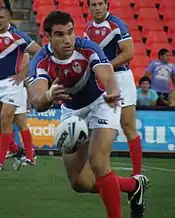Five-eighth
Five-eighth or Stand-off is one of the positions in a rugby league football team. Wearing jersey number 6, this player is one of the two half backs in a team, partnering the scrum-half.[1][2][3] Sometimes known as the pivot or second receiver,[4] in a traditional attacking 'back-line' (No. 1-7)[5] play, the five-eighth would receive the ball from the scrum half,[6] who is the first receiver of the ball from the dummy-half or hooker following a tackle.

The role of the five-eighth is often to pass the ball away from the congested area around the tackle, further out along the 'back-line' to the outside backs, the centres and wingers, who have more space to run with it.[7][8] Furthermore, players in this position typically assume responsibility for kicking the ball for field position in general play.[9][10] The five-eighth is therefore considered one of the most important positions, often referred to as a 'play maker', assuming a decision-making role on the field.[11][12] Over time, however, as the game has evolved, the roles of the two halves have grown more aligned and difficult to distinguish.[13] Along with other key positions – fullback, hooker and scrum half – the five-eighth makes up what is known as a team's spine.[14]
One book published in 1996 stated that in senior rugby league, the five-eighth and hooker handled the ball more often than any other positions.[15]
The Rugby League International Federation's Laws of the Game state that the "Stand-off half or Five-eighth" is to be numbered 6.[16] However, traditionally players' jersey numbers have varied, and in the modern Super League, each squad's players are assigned individual numbers regardless of position.
Etymology
.jpg.webp)
Traditionally in rugby football, there have always been two half-backs as well as scrums involving the forwards. Of the two half backs, the name "scrum half" was given to the one which was involved in the scrum by feeding the ball into it and the name "stand-off half" was given to the one which stood off to the side of the scrum.[17] In Britain, where rugby league originated, this terminology has been retained.[18] In Australian English, however, "five-eighth" is the term used for the number 6, to differentiate from the "half back" which is the name commonly given to the number 7.[19] In New Zealand, both terms appear to be used interchangeably.
Notable stand-offs
Five-eighths that feature in their respective nations' rugby league halls of fame are England's Roger Millward, Australia's Wally Lewis, Bob Fulton, Brett Kenny, Albert Rosenfeld and Vic Hey, and New Zealand's George Menzies.
Rugby league's first known black player, Lucius Banks, played in the position for Hunslet R.L.F.C. in 1912-13.[20]
References
- "The NRL's 10 best halves combos". NRL.com. National Rugby League. Retrieved 4 September 2013.
- McDonald, Margie (11 November 2006). "Finch to be five-eighth". The Australian. Retrieved 4 September 2013.
- Jancetic, Steve (12 May 2010). "Lyon backs away from five-eighth role". Wide World of Sports. Archived from the original on 16 October 2014. Retrieved 4 September 2013.
- Dillon, Robert (1 April 2012). "Mullen finds a home in pivotal role for Knights". The Newcastle Herald. Retrieved 4 September 2013.
- Hickey, Julia (2006). Understanding Rugby League. UK: Coachwise. ISBN 9781905540105.
- Thompson, Michael (21 July 2011). "Thompson now calling the shots". Townsville Bulletin. Retrieved 4 September 2013.
- Gould, Phil (22 February 2004). "Why is their number up?". The Sun-Herald. Retrieved 4 September 2013.
- Hickie, David (1 March 1987). "The Trend toward Robot League". The Sun-Herald. Retrieved 4 September 2013.
- Ryan, Nathan (8 May 2013). "James Maloney backed for NSW five-eighth based on his kicking game says Nathan Hindmarsh". The Australian. Retrieved 4 September 2013.
- Ritchie, Dean (9 June 2011). "NSW five-eighth Jamie Soward vows dominant kicking game in State of Origin II". Herald Sun. Retrieved 4 September 2013.
- "Positions guide: Stand-off". Rugby league: Laws & Equipment. BBC News. Retrieved 4 September 2013.
- Gardini, Adam (8 January 2008). "Rogers eager to play five-eighth". goldcoast.com.au. Retrieved 4 September 2013.
- Knox, Ron (20 February 2006). "The Role of half backs: Where we are strongest". comeallwithin.co.uk. Retrieved 4 September 2013.
- Badel, Peter (1 September 2013). "Darren Lockyer urges Anthony Griffin to stop tinkering with the spine of the Brisbane Broncos". The Courier-Mail. Retrieved 4 September 2013.
- Tim Rogers and Richard Beesley (2006). Fitness for Rugby League (PDF). Australia: coachrugbyleague.com.au. Archived from the original (PDF) on 2012-10-21. Retrieved 2013-09-04.
- The International Laws of the Game and Notes of the Laws (PDF). RLIF. 2007. p. 9.
- Crego, Robert (2003). Sports and Games of the 18th and 19th Centuries. USA: Greenwood Press. pp. 101–104. ISBN 978-0-313-31610-4.
- Hickey, Julia (2006). Understanding Rugby League. UK: Coachwise. p. 17. ISBN 978-1-905540-10-5.
- Australian Language & Culture. Australia: Lonely Planet. 2007. p. 83. ISBN 978-1-74059-099-0.
- Collins, Tony (1998). "Racial minorities in a marginalized sport: Race, discrimination and integration in British rugby league football". Immigrants & Minorities. 17: 151–169. doi:10.1080/02619288.1998.9974933.